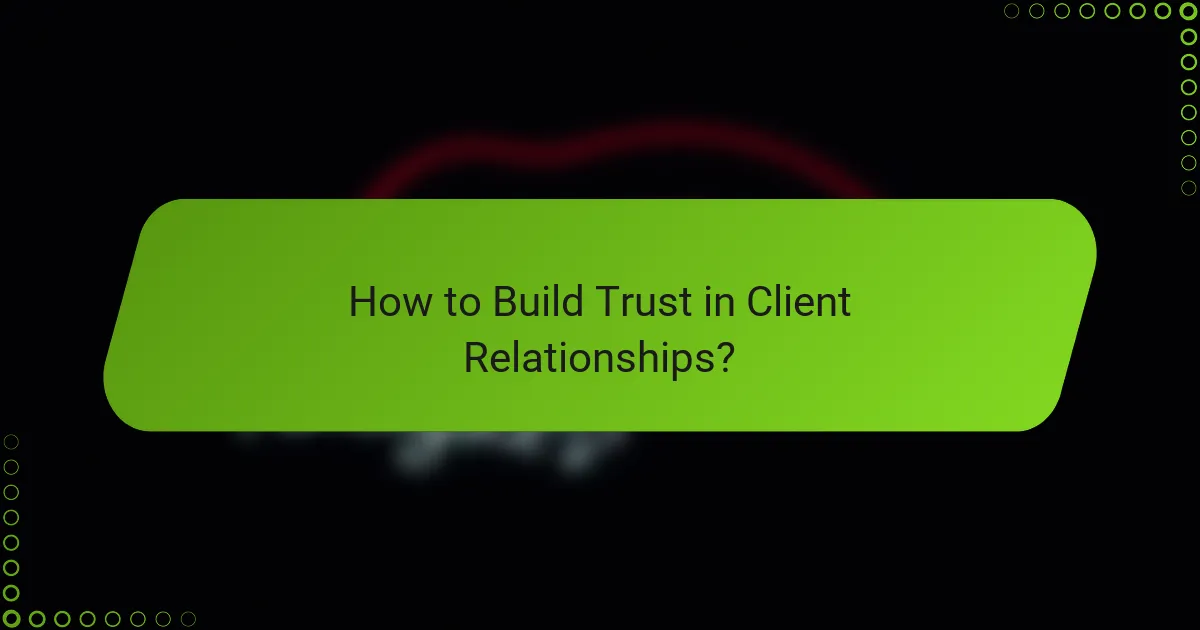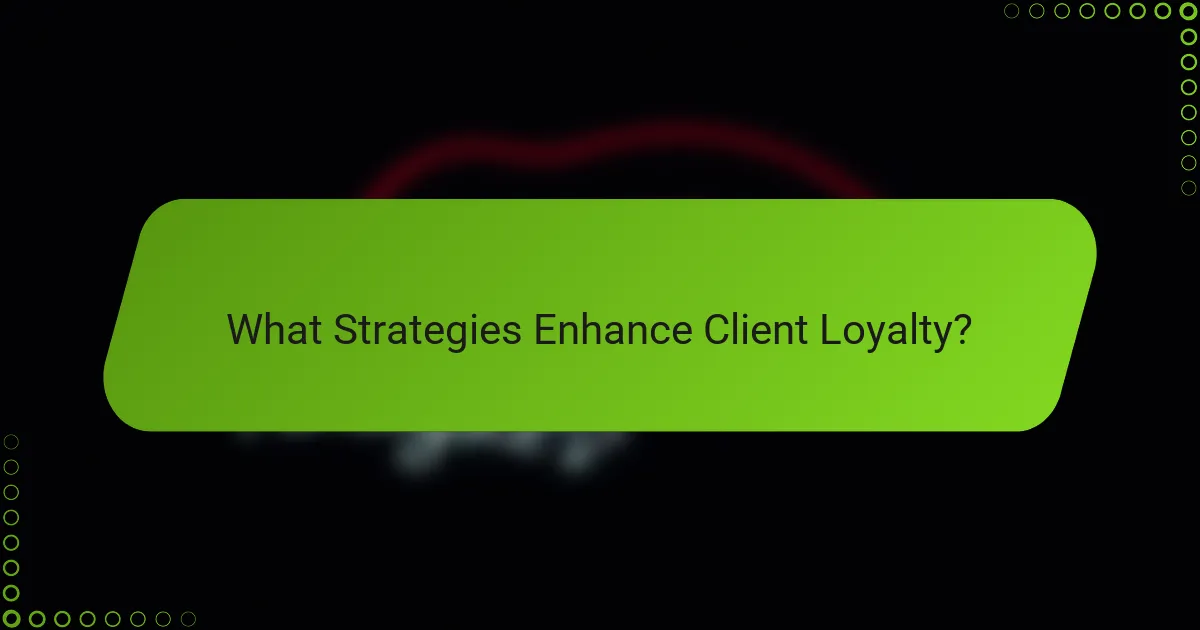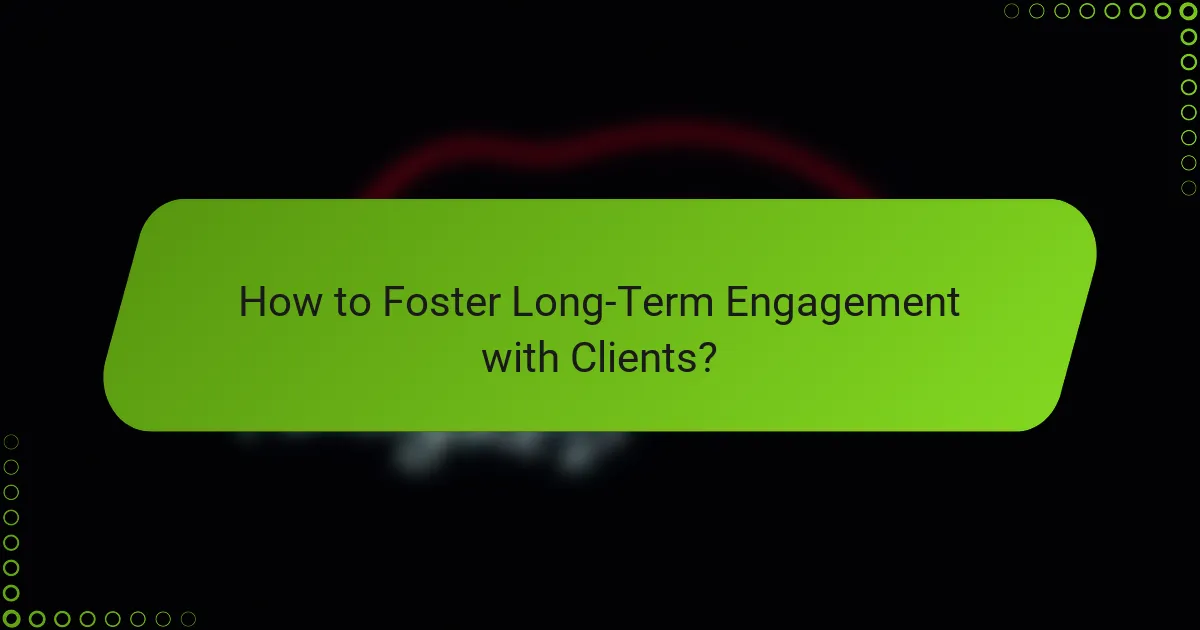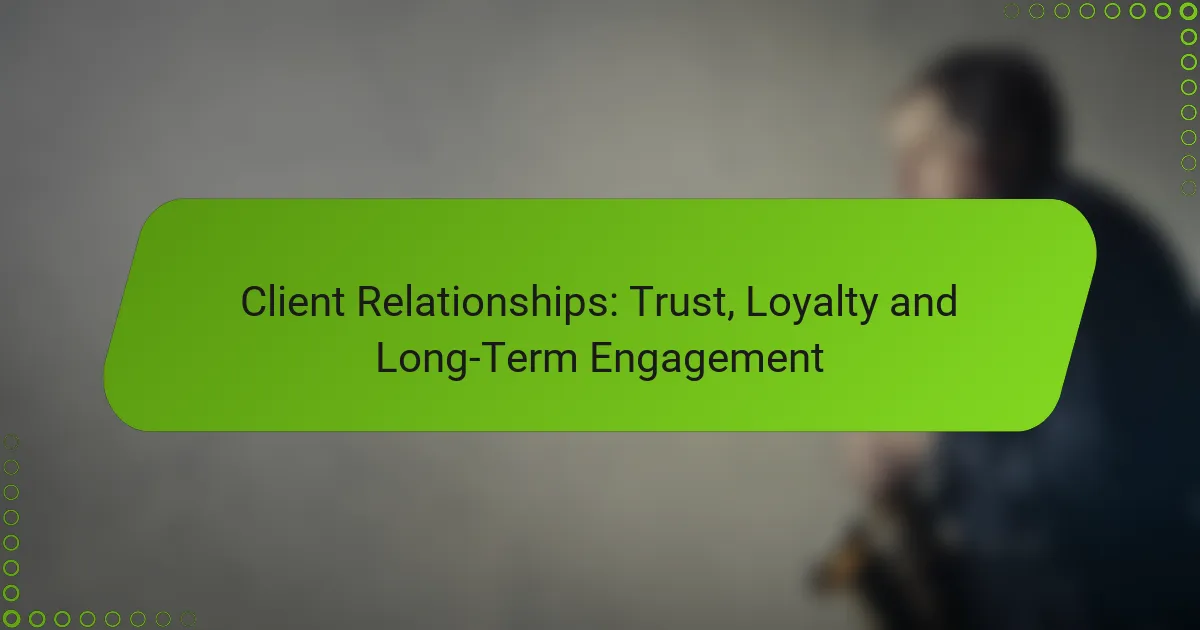Client relationships thrive on trust, loyalty, and long-term engagement, which are essential for sustainable business success. By prioritizing open communication, personalized interactions, and consistent value delivery, companies can cultivate strong bonds with their clients. Implementing strategies such as reward programs and active social media engagement further enhances loyalty and fosters enduring connections.

How to Build Trust in Client Relationships?
Building trust in client relationships involves establishing open communication, consistently meeting expectations, personalizing interactions, and implementing regular feedback mechanisms. These elements create a foundation for loyalty and long-term engagement.
Transparent communication
Transparent communication means sharing information openly and honestly with clients. This includes being clear about processes, timelines, and any potential challenges that may arise. Clients appreciate when they are kept in the loop, which fosters a sense of partnership.
To enhance transparency, consider regular updates through emails or meetings. Use straightforward language and avoid jargon to ensure clients fully understand the information being shared.
Consistent delivery of promises
Consistently delivering on promises is crucial for building trust. When clients see that you follow through on commitments, they are more likely to rely on your services. This consistency can be achieved by setting realistic expectations and ensuring that your team is aligned on deliverables.
Avoid overpromising; instead, under-promise and over-deliver when possible. This approach can lead to positive surprises and reinforce trust over time.
Personalized interactions
Personalized interactions help clients feel valued and understood. Tailoring your communication and services to meet individual client needs can significantly enhance their experience. This could involve remembering key details about their preferences or adapting your approach based on their feedback.
Utilize customer relationship management (CRM) tools to track client interactions and preferences. This data can help you provide a more customized experience, which strengthens the client relationship.
Regular feedback mechanisms
Implementing regular feedback mechanisms allows clients to voice their opinions and concerns. This can be done through surveys, one-on-one meetings, or feedback forms. Actively seeking input shows clients that their opinions matter and that you are committed to improving your services.
Make it easy for clients to provide feedback by keeping surveys short and focused. Responding to feedback promptly and making necessary adjustments can further enhance trust and loyalty.

What Strategies Enhance Client Loyalty?
Enhancing client loyalty involves implementing strategies that foster trust and long-term engagement. Effective methods include reward programs, exclusive offers, and active engagement through social media, each contributing to a stronger client relationship.
Reward programs
Reward programs incentivize repeat business by offering clients benefits for their loyalty. These can range from points systems that accumulate for discounts to tiered memberships that unlock exclusive perks.
For example, a retail store might offer a loyalty card that gives customers one point for every dollar spent, redeemable for discounts after reaching a certain threshold. Consider the balance between rewards offered and the cost to your business to ensure sustainability.
Exclusive offers
Exclusive offers create a sense of privilege among clients, making them feel valued. These can include limited-time discounts, early access to new products, or special bundles available only to loyal customers.
For instance, a subscription service might provide a 20% discount on a new product launch exclusively for existing subscribers. It’s essential to communicate these offers clearly to maximize their impact and encourage continued engagement.
Engagement through social media
Active engagement on social media platforms helps build a community around your brand, fostering loyalty. Regularly posting content that resonates with your audience can keep clients connected and invested in your brand.
Consider hosting Q&A sessions, sharing user-generated content, or running contests to encourage interaction. Be responsive to comments and messages to strengthen relationships and demonstrate that you value client feedback.

How to Foster Long-Term Engagement with Clients?
To foster long-term engagement with clients, focus on building trust and demonstrating consistent value. Establishing strong relationships requires ongoing communication, delivering relevant content, and investing in client education.
Regular check-ins
Regular check-ins are essential for maintaining strong client relationships. Schedule periodic meetings or calls to discuss their needs, gather feedback, and address any concerns. Aim for monthly or quarterly check-ins, depending on the nature of your service or product.
During these interactions, actively listen to your clients and adapt your offerings based on their feedback. This shows that you value their input and are committed to their success.
Value-added content
Providing value-added content can significantly enhance client engagement. Share relevant articles, industry reports, or case studies that align with their interests and challenges. This not only positions you as a knowledgeable partner but also keeps clients informed about trends that may impact their business.
Consider creating a monthly newsletter or a dedicated resource section on your website where clients can access this content easily. Tailoring the content to their specific needs can further strengthen your relationship.
Client education initiatives
Implementing client education initiatives can empower your clients and deepen their loyalty. Offer workshops, webinars, or training sessions that help them better understand your products or services. This not only enhances their skills but also demonstrates your commitment to their growth.
Additionally, providing easy-to-follow guides or video tutorials can make it easier for clients to utilize your offerings effectively. Ensure that these resources are accessible and relevant to their specific context, which can lead to increased satisfaction and long-term engagement.

What Metrics Measure Client Relationship Success?
Client relationship success can be measured through various metrics that indicate satisfaction, loyalty, and engagement. Key metrics include Net Promoter Score (NPS), Customer Lifetime Value (CLV), and retention rates, each providing insights into different aspects of client relationships.
Net Promoter Score (NPS)
Net Promoter Score (NPS) gauges client loyalty by asking how likely clients are to recommend a business to others. Responses are categorized into promoters, passives, and detractors, allowing businesses to calculate a score that ranges from -100 to +100.
A high NPS indicates strong client loyalty and satisfaction, while a low score suggests areas needing improvement. Regularly measuring NPS can help identify trends over time and inform strategies to enhance client relationships.
Customer Lifetime Value (CLV)
Customer Lifetime Value (CLV) estimates the total revenue a business can expect from a client over their entire relationship. Understanding CLV helps businesses allocate resources effectively and tailor marketing efforts to retain high-value clients.
To calculate CLV, consider factors such as average purchase value, purchase frequency, and client lifespan. A higher CLV signifies a successful client relationship, while a lower CLV may indicate the need for improved engagement strategies.
Retention rates
Retention rates measure the percentage of clients that continue to do business with a company over a specific period. High retention rates are indicative of strong client relationships and satisfaction, while low rates may signal issues that need addressing.
To improve retention rates, businesses should focus on providing excellent customer service, regular communication, and personalized experiences. Tracking retention over time can reveal patterns and help identify effective strategies for maintaining long-term client engagement.

What Are the Best Practices for Client Relationship Management?
Effective client relationship management (CRM) focuses on building trust, fostering loyalty, and ensuring long-term engagement. Best practices include utilizing technology, understanding client needs, and maintaining consistent communication.
Utilizing CRM tools
CRM tools are essential for managing client relationships efficiently. They help track interactions, store client information, and analyze data to improve service. Popular options include Salesforce, HubSpot, and Zoho, which offer various features tailored to different business sizes.
When selecting a CRM tool, consider factors such as ease of use, integration capabilities, and cost. Many platforms offer tiered pricing, allowing businesses to choose a plan that fits their budget, typically ranging from a few dozen to several hundred dollars per month.
Regularly updating and maintaining your CRM system is crucial. Ensure that all client data is accurate and current to avoid miscommunication and enhance relationship-building efforts.
Segmenting client base
Segmenting your client base involves categorizing clients based on shared characteristics, such as demographics, purchasing behavior, or engagement levels. This practice allows for tailored communication and personalized service, which can significantly enhance client satisfaction and loyalty.
To effectively segment your clients, analyze data from your CRM system and identify key trends. For example, you might group clients by their spending habits or the frequency of their purchases. This enables targeted marketing strategies that resonate with each segment.
Be cautious not to over-segment, as this can complicate your marketing efforts and dilute your messaging. Aim for a balance that allows for personalization while maintaining operational efficiency.
